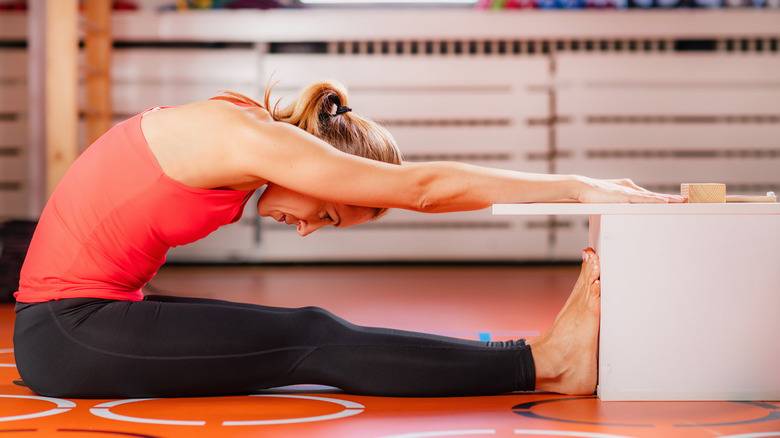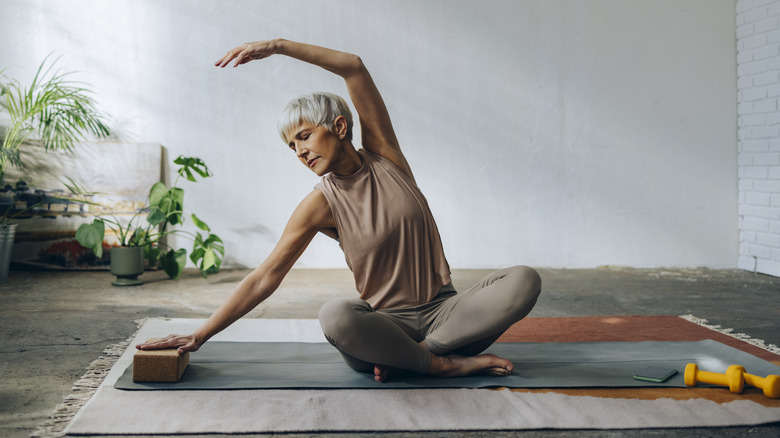Do This With Your Toes At Least Once A Year To Test Your Heart Health
Your arteries are like small garden hoses that carry oxygen-rich blood throughout your body. They see a lot of pressure with each beat of your heart, so your arteries need to be flexible to expand and contract to accommodate this pressure, particularly the arteries around your heart (per the National Library of Medicine).
As you age, your arteries begin to narrow and stiffen, making it difficult for your arteries to efficiently pump blood. According to Mount Sinai, high cholesterol, diabetes, obesity, inactivity, and high blood pressure can increase arterial stiffness and lead to a stroke or heart attack. Getting enough cardiovascular exercise can help delay age-related hardening of the arteries.
The elasticity of your connective tissue can factor into arterial stiffness, so a 2009 article in the American Journal of Physiology looked at whether the flexibility of the body is linked to the elasticity of the arteries. The results showed that in middle-aged and older individuals, those with lower flexibility exhibited higher arterial stiffness compared to their more flexible counterparts. The researchers used the sit-and-reach test to measure the participants' flexibility. Therefore, you can try the sit-and-reach test not only to measure your flexibility but also to predict your likelihood of age-related arterial stiffness that can lead to a heart attack or stroke.
How to do the sit-and-reach test
The sit-and-reach test measures the flexibility of your back and hamstrings, which can factor into preventing injuries, avoiding falls, and changes in your walking stride and posture, according to Physiopedia. To do the test at home, begin doing some easy stretches with your shoes off. Place a yardstick on the floor and use about a foot of masking tape to mark off at the 15-inch mark. Use a long enough piece of tape because you'll be using this 15-inch mark as a placement for your heels.
Sit on the floor and anchor your heels at the 15-inch mark on the yardstick. Your feet should be between 10 and 12 inches apart. Keeping your feet where they are, scoot yourself back so your legs are straight in front of you with your feet flexed. The yardstick will be between your legs, with the longer end extending past your feet.
With one hand on top of the other, palms down, and your fingers aligned, reach forward as far as you can and hold for two seconds. Note where the tips of your fingers reach. You don't need to reach down to the ruler because the sit-and-reach test typically puts the ruler on a foot-high box to make it easier to read the measurement. Repeat this two more times, and record your best reach.
How to interpret your sit and reach score
On average, the tips of your fingers should be able to reach your toes, particularly if you're younger. Women might be able to reach an inch or two further than men. Even reaching a few inches beyond your toes can put your flexibility above average, while a few inches short of your feet means you might need to work on your flexibility (per Physiopedia). Don't be discouraged if your sit-and-reach test score isn't very high. According to Cartwright Fitness, you could be really flexible but have long legs and a short torso. Or your score might be above average if you have a long torso and short legs.
Obviously, you can improve your sit-and-reach test score by doing more forward bends like this. You can incorporate a flexibility program after your cardiovascular or strength training exercise. Your stretching program can be its own stand-alone session if you warm up your muscles with a short walk. The American Heart Association suggests stretching three to five days a week, choosing a few stretches to reach all the major body parts. Use your stretching session to incorporate deep breathing and relaxation as you hold each stretch for 10 to 30 seconds. Avoid locking out your joints with your stretches, and never stretch to the point of pain.



